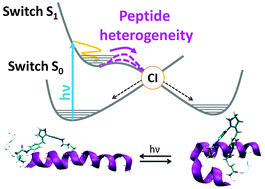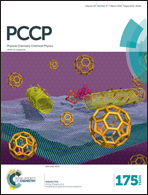A biomimetic molecular switch at work: coupling photoisomerization dynamics to peptide structural rearrangement†
Abstract
In spite of considerable interest in the design of molecular switches towards photo-controllable (bio)materials, few studies focused on the major influence of the surrounding environment on the switch photoreactivities. We present a combined experimental and computational study of a retinal-like molecular switch linked to a peptide, elucidating the effects on the photoreactivity and on the α-helix secondary structure. Temperature-dependent, femtosecond UV-vis transient absorption spectroscopy and high-level hybrid quantum mechanics/molecular mechanics methods were applied to describe the photoisomerization process and the subsequent peptide rearrangement. It was found that the conformational heterogeneity of the ground state peptide controls the excited state potential energy surface and the thermally activated population decay. Still, a reversible α-helix to α-hairpin conformational change is predicted, paving the way for a fine photocontrol of different secondary structure elements, hence (bio)molecular functions, using retinal-inspired molecular switches.


 Please wait while we load your content...
Please wait while we load your content...